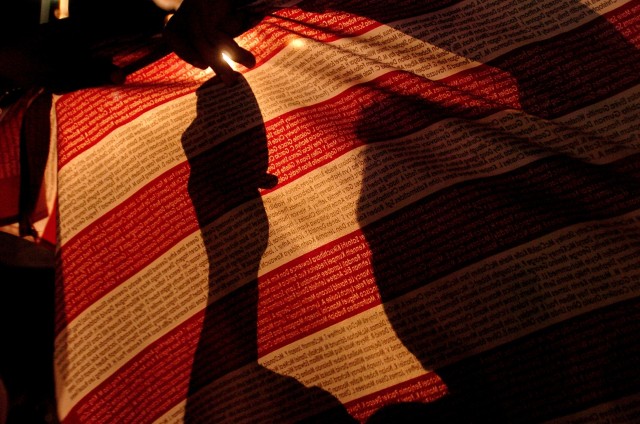
WASHINGTON (Army News Service, Sept. 19, 2001) -- The casualty toll at the Pentagon may have been much worse Sept. 11, 2001, officials said, without the heroic actions of many Soldiers and civilian employees that day.
"There were an unknown number of acts of personal courage and heroism," said then-Brig. Gen. Clyde A. Vaughn, who was serving as deputy director of military support to civil authorities.
Vaughn said he was returning to the Pentagon that morning when he saw a Boeing 757 slam into the west side of the building. He saw people coming out of the building limping badly, he said, "and every one of them had two or three people caring for them and comforting them."
Lt. Col. Ted Anderson carried two of the injured away from the burning building. Then he re-entered the smoke-filled Pentagon through a broken window to drag out two more injured employees, one whose clothes were on fire.
Anderson kicked open an interior door and with the help of two others, carried a heavy woman out of the building and boosted her through the broken window. Then back inside a dark corridor, Anderson said he saw a flash go by and realized a man's clothes were on fire. He tackled the employee and rolled him on the ground to extinguish the flames.
After helping the burn victim out through the window, Anderson turned to go back in again, but was stopped by two firemen who grabbed his shoulders and struggled to keep him from returning into the flames that had ignited from the jet fuel. Anderson said he was upset with the firemen for not letting him go back.
"You don't leave your comrades on the battlefield," said Anderson, a field artillery officer who worked in the Office of the Chief of Legislative Liaison. "To me, this was the battlefield."
Staff Sgt. Christopher Braman, a cook at the Pentagon, and a ranger at heart, also went back inside the burning Pentagon to assist people. Sheila Moody was clapping her hands, hoping someone would hear her. She couldn't speak because of intense smoke inhalation. Braman heard her, and brought her out.
It was Moody's second day on the job Sept. 11, and in an appearance on the Oprah Winfrey show she told the world that Braman was her guardian angel that day.
Braman also helped to find and recover a number of casualties from the Pentagon, volunteering to stay on site into the night working with first responders. He received the Purple Heart for his injuries and the Soldier's Medal for his bravery.
Brig. Gen. Glenn Webster, then-director of Training in the Office of the Deputy Chief of Staff for Operations and Plans, was in the section of the building one floor above where the plane hit. He and most of his staff were able to get downstairs and outside before the floor caved in.
Everybody moved quickly into the hallway, Webster said, and then a fireball shot forward along the suspended ceiling. Chunks of the suspended ceiling began to fall, he said, as Soldiers checked stairwells for heat and smoke to find the safest way out. He said a few others actually ran atop part of the burning aircraft to get out.
"Soldiers were helping badly burned and cut personnel out of the building," Webster said. He said other soldiers used debris to break windows open and pull people out.
A contract employee who worked with Webster, retired Sgt. Maj. Ron Schexnayder, went back upstairs to get a flashlight to help guide people out.
"All the lights went off immediately after the big explosion," Schexnayder explained. He moved debris out of the way so people could get through.
Once outside, Webster helped perform first aid on a number of the fire victims. He treated them for shock by loosening clothing, removing shoes, propping up their feet and covering them with whatever he could find. He helped a nurse and medic triage the victims and held an IV bag for one patient.
Spc. Beau Doboszenski also helped provide first aid to the injured immediately following the plane crash.
A soldier with B. Co., 3rd U.S. Infantry, Doboszenski had been trained as an emergency medical technician before joining the Army. He served as a volunteer firefighter and EMT in Loretto, Minn., before enlisting.
"I come from a family of fire fighters," Doboszenski said.
Doboszenski was working in the Pentagon as a tour guide the morning the aircraft struck the building. The Tour Guide office is on the opposite end of the building from where the plane hit, so Doboszenski didn't even hear the explosion. But he heard a Navy captain screaming for anyone with medical training.
Doboszenski ran around the building, was stopped by police, so he went around barricades and ran down the George-Washington Parkway. He reached Pentagon North Parking where medics from the health clinic were beginning to perform triage on victims of the blast and fire. He joined in to help.
He treated a woman who was having trouble breathing and placed a tube down her throat. Then he helped load the woman and about 20 others who were injured into automobiles so they could be taken to a nearby hospital.
Doboszenski then went with a six-man team into the building where the fire was still blazing. They placed doused rags around their faces and spent an hour in calf-deep water searching for survivors.
(The original version of this article appeared on the Army News Service Sept. 19, 2001. The paragraphs on Staff Sgt. Chris Braman first appeared in an ARNEWS article by then-Staff Sgt. Marcia Triggs on Dec. 26, 2001. Triggs is now a master sergeant and recently returned from a tour in Iraq with the 3rd Infantry Division.)

Social Sharing